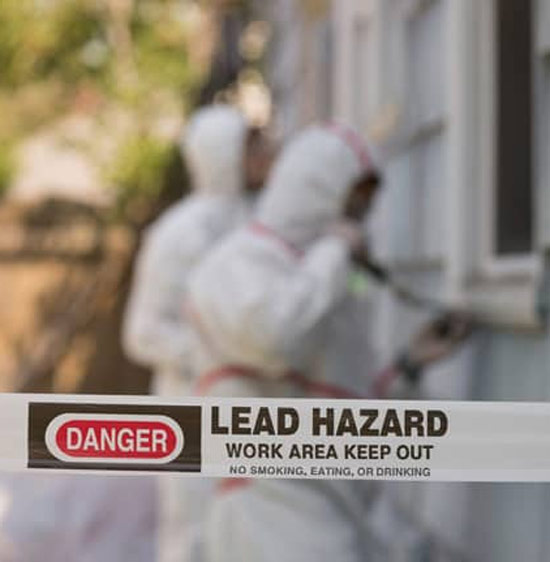Step-by-Step Process for Effective Lead Infraction Remediation
Dealing with lead infractions requires a thorough and organized strategy to ensure both safety and security and governing compliance. The trip begins with the precise discovery and analysis of contamination sources, utilizing cutting-edge analysis devices. Following this, adherence to federal and state laws is extremely important to creating a reliable removal plan. Such a plan should detail the certain methods and timelines for activity. The real remediation requires competent workers to implement these strategies while purely complying with security protocols. Yet what takes place after the remediation is completed? The answer depends on recognizing the necessary post-remediation methods that guarantee long-term safety and security and neighborhood well-being.

Discovery and Assessment
Detection and assessment are critical steps in the removal of lead offenses. To make sure a reliable remediation process, it is necessary to perform an extensive assessment of the setting where possible lead direct exposure exists.
Once detection is achieved, a detailed analysis has to be undertaken. This includes evaluating the extent and seriousness of contamination, in addition to determining populations at danger, specifically youngsters and expectant females. Threat analyses usually entail tasting and research laboratory evaluation, ecological studies, and wellness effect researches. The collected data ought to be carefully documented to support the development of an effective remediation strategy (Lead Violation Removal in NYC).
Additionally, it is imperative to focus on locations with the greatest degrees of contamination and those that posture the best wellness dangers. Effective communication with stakeholders, consisting of building proprietors, locals, and public health officials, is crucial for guaranteeing that all events are notified concerning the findings and the succeeding actions required for removal. This preliminary detection and evaluation phase lays the foundation for a successful lead offense remediation procedure.

Legal and Governing Compliance
Navigating the landscape of lawful and regulative compliance is an essential element of successful lead offense remediation. Conformity makes sure not only the safety and security of afflicted populations however also the credibility and lawful standing of the organization liable for remediation. Rules regulating lead contamination are complex, including government, state, and regional regulations. At the federal degree, the Epa (EPA) sets stringent requirements under the Toxic Compounds Control Act (TSCA) and the Lead-Based Paint Renovation, Fixing, and Painting Policy (RRP Guideline)
State and regional laws can vary, frequently imposing extra responsibilities or even more stringent requirements. Consequently, a detailed understanding of all appropriate legal frameworks is important. This involves meticulous documentation of all removal tasks to demonstrate compliance. Failure to adhere to these regulations can lead to severe penalties, consisting of substantial penalties, lawsuit, and reputational damage.
Engaging legal specialists concentrated on ecological law can facilitate browsing these intricacies. Regular training and certification for all employees included in the remediation procedure are likewise obligatory to make certain adherence to safety and security and regulative standards. By focusing on legal and regulatory conformity, organizations can effectively minimize dangers and achieve an effective remediation end result.
Planning the Removal
Effectively planning the removal of lead infractions starts with a detailed analysis of the contaminated website. This data-driven strategy guarantees that removal initiatives are appropriately targeted and effective.
As soon as the contamination is mapped, a risk assessment must be performed to evaluate prospective health and wellness threats to humans and the atmosphere. Lead Violation Removal in NYC. This evaluation needs to think about variables such as direct exposure paths, populace susceptability, and ecological impacts. The insights gathered will certainly develop the basis for picking an ideal removal strategy
Subsequently, setting clear, achievable goals for the remediation job is critical. These purposes should align with regulatory standards and stakeholder expectations to guarantee compliance and community acceptance. Developing a comprehensive remediation plan that describes techniques, timelines, and source allocation will certainly facilitate a structured approach to the cleanup process.
Furthermore, it is important to engage with stakeholders early and maintain transparent communication throughout the preparation stage. This consists of educating local areas, getting necessary permits, and collaborating with governing firms to ensure all legal and procedural requirements are met. A well-crafted remediation plan not only addresses the contamination successfully yet also builds count on and participation amongst all events included.
Carrying Out the Remediation
With a well-structured remediation strategy in position, the emphasis moves to the actual implementation of the remediation tasks. This phase involves setting in motion the required sources, including competent personnel, customized equipment, and high-quality products. Begin by clearly defining roles and duties to guarantee liability and seamless control among group participants.
The preliminary action in execution is to safeguard the site. This consists of establishing control areas to protect against lead dust and particles from spreading, in addition to employing air purification systems to look at this site preserve air top quality. Next off, more info here proceed with the elimination of lead-based products. Utilize approaches such as wet scuffing, chemical removing, or encapsulation, depending on the intensity and area of the contamination. It is critical to comply with safety and security protocols, including the usage of individual protective devices (PPE) and correct disposal of hazardous materials.
Throughout the remediation process, conduct regular assessments and air top quality keeping an eye on to make sure conformity with regulatory requirements. Efficient interaction with stakeholders, including building proprietors and owners, is essential to keep them notified of development and any type of unforeseen growths. By diligently adhering to these actions, the removal tasks can be implemented successfully and properly, inevitably mitigating lead dangers.
Post-Remediation Strategies
Post-remediation methods play an important role in making certain the lasting success of lead offense removal efforts. These strategies encompass recurring tracking, maintenance, and community education and learning to stop future lead direct exposure and guarantee a safe setting.
First, normal tracking is vital. This involves routine screening of the previously affected locations to make sure that lead levels continue to be within risk-free limitations. Homeowner need to develop a routine for these examinations, ideally in collaboration with qualified environmental specialists.

Third, educating the community plays a pivotal duty in maintaining the benefits of removal. Homeowners and home supervisors must be informed about the threats of lead exposure and the best practices for maintaining a lead-safe environment. Workshops, informational handouts, and neighborhood meetings can be reliable tools for disseminating this details.
Verdict
Effective lead violation remediation needs a detailed, organized strategy incorporating discovery and analysis of contamination, adherence see here to lawful and regulatory standards, meticulous planning, and effective execution of remediation initiatives. This systematic procedure emphasizes the relevance of thoroughness and alertness in resolving and mitigating lead contamination.